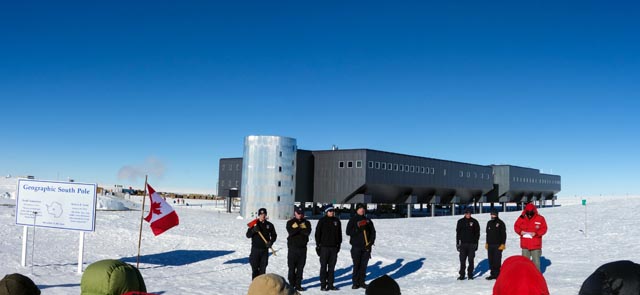
Photo Credit: Jeffrey Donenfeld |
|
Tragedy in Antarctica
Memorial service held at South Pole for air crew killed in plane crash
By Peter Rejcek, Antarctic Sun Editor
Posted January 29, 2013
The Antarctic community mourned the loss of three men who were killed when their de Havilland DHC-6 Twin Otter crashed in the Transantarctic Mountains last week. Above, a memorial service is held at the South Pole Station  . The South Pole Fire Department crewmembers hold their axes while station manager Bill Coughran, far right, reads a poem by World War II aviator and poet John Gillespie Magee, Jr. The Canadian flag flies next to the geographic pole.
. The South Pole Fire Department crewmembers hold their axes while station manager Bill Coughran, far right, reads a poem by World War II aviator and poet John Gillespie Magee, Jr. The Canadian flag flies next to the geographic pole.
Kelly Falkner, director of the National Science Foundation's Division of Polar Programs  , said in a prepared statement
, said in a prepared statement  , "We have been privileged to experience first-hand their professionalism, skill, and dedication to the arduous task of supporting science in an extremely remote and inhospitable environment. In many ways, their contributions make possible hard won but vital advances in scientific knowledge that serve all of mankind. Although everyone associated with the pursuit of science in Antarctica makes personal sacrifices to do so, very infrequently and sadly, some make the ultimate sacrifice."
, "We have been privileged to experience first-hand their professionalism, skill, and dedication to the arduous task of supporting science in an extremely remote and inhospitable environment. In many ways, their contributions make possible hard won but vital advances in scientific knowledge that serve all of mankind. Although everyone associated with the pursuit of science in Antarctica makes personal sacrifices to do so, very infrequently and sadly, some make the ultimate sacrifice."
The Canadian flag at Palmer Station  flew at half-staff, while a memorial service at McMurdo Station
flew at half-staff, while a memorial service at McMurdo Station  was being planned. In the daily report from field supervisor Tim Thomas of the South Pole Traverse, the team also sent out a message on their last day on the polar plateau: "Today was a solemn day for many in our community, as we remember and send our thoughts and prayers to the friends and family of KBA's crew. 'And I said, Oh that I had wings like a dove! for then I would fly away and be at rest.' Ps. 55:6."
was being planned. In the daily report from field supervisor Tim Thomas of the South Pole Traverse, the team also sent out a message on their last day on the polar plateau: "Today was a solemn day for many in our community, as we remember and send our thoughts and prayers to the friends and family of KBA's crew. 'And I said, Oh that I had wings like a dove! for then I would fly away and be at rest.' Ps. 55:6."
Communication with the Twin Otter was lost on the night of Jan. 23 (New Zealand time), as the plane left the South Pole Station for an Italian research base at Terra Nova Bay. On Jan. 26, local time, a ski-equipped LC-130 aircraft  , operated by the New York Air National Guard
, operated by the New York Air National Guard  for the U.S. Antarctic Program
for the U.S. Antarctic Program  , flew over the last known position from the aircraft emergency beacon and spotted the aircraft tail at an elevation of about 13,000 feet on the side of Mount Elizabeth. A U.S.-New Zealand joint search and rescue team was later able to reach the site by helicopter and recover the cockpit voice recorder. Conditions were not safe for further recovery operations. See the National Science Foundation press release
, flew over the last known position from the aircraft emergency beacon and spotted the aircraft tail at an elevation of about 13,000 feet on the side of Mount Elizabeth. A U.S.-New Zealand joint search and rescue team was later able to reach the site by helicopter and recover the cockpit voice recorder. Conditions were not safe for further recovery operations. See the National Science Foundation press release  for further details.
for further details.





